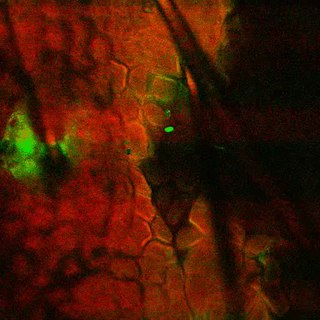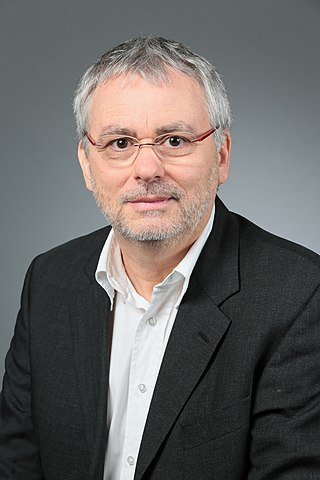Tunable diode laser absorption spectroscopy is a technique for measuring the concentration of certain species such as methane, water vapor and many more, in a gaseous mixture using tunable diode lasers and laser absorption spectrometry. The advantage of TDLAS over other techniques for concentration measurement is its ability to achieve very low detection limits. Apart from concentration, it is also possible to determine the temperature, pressure, velocity and mass flux of the gas under observation. TDLAS is by far the most common laser based absorption technique for quantitative assessments of species in gas phase.
Cavity ring-down spectroscopy (CRDS) is a highly sensitive optical spectroscopic technique that enables measurement of absolute optical extinction by samples that scatter and absorb light. It has been widely used to study gaseous samples which absorb light at specific wavelengths, and in turn to determine mole fractions down to the parts per trillion level. The technique is also known as cavity ring-down laser absorption spectroscopy (CRLAS).
A fiber laser is a laser in which the active gain medium is an optical fiber doped with rare-earth elements such as erbium, ytterbium, neodymium, dysprosium, praseodymium, thulium and holmium. They are related to doped fiber amplifiers, which provide light amplification without lasing.

Silicon photonics is the study and application of photonic systems which use silicon as an optical medium. The silicon is usually patterned with sub-micrometre precision, into microphotonic components. These operate in the infrared, most commonly at the 1.55 micrometre wavelength used by most fiber optic telecommunication systems. The silicon typically lies on top of a layer of silica in what is known as silicon on insulator (SOI).

In optics, a supercontinuum is formed when a collection of nonlinear processes act together upon a pump beam in order to cause severe spectral broadening of the original pump beam, for example using a microstructured optical fiber. The result is a smooth spectral continuum. There is no consensus on how much broadening constitutes a supercontinuum; however researchers have published work claiming as little as 60 nm of broadening as a supercontinuum. There is also no agreement on the spectral flatness required to define the bandwidth of the source, with authors using anything from 5 dB to 40 dB or more. In addition the term supercontinuum itself did not gain widespread acceptance until this century, with many authors using alternative phrases to describe their continua during the 1970s, 1980s and 1990s.
Photothermal spectroscopy is a group of high sensitivity spectroscopy techniques used to measure optical absorption and thermal characteristics of a sample. The basis of photothermal spectroscopy is the change in thermal state of the sample resulting from the absorption of radiation. Light absorbed and not lost by emission results in heating. The heat raises temperature thereby influencing the thermodynamic properties of the sample or of a suitable material adjacent to it. Measurement of the temperature, pressure, or density changes that occur due to optical absorption are ultimately the basis for the photothermal spectroscopic measurements.
Laser absorption spectrometry (LAS) refers to techniques that use lasers to assess the concentration or amount of a species in gas phase by absorption spectrometry (AS).
Noise-immune cavity-enhanced optical-heterodyne molecular spectroscopy (NICE-OHMS) is an ultra-sensitive laser-based absorption technique that utilizes laser light to assess the concentration or the amount of a species in gas phase by absorption spectrometry (AS).

Francisco Javier "Frank" Duarte is a laser physicist and author/editor of several books on tunable lasers.
Ultrasound-modulated optical tomography (UOT), also known as Acousto-Optic Tomography (AOT), is a hybrid imaging modality that combines light and sound; it is a form of tomography involving ultrasound. It is used in imaging of biological soft tissues and has potential applications for early cancer detection. As a hybrid modality which uses both light and sound, UOT provides some of the best features of both: the use of light provides strong contrast and sensitivity ; these two features are derived from the optical component of UOT. The use of ultrasound allows for high resolution, as well as a high imaging depth. However, the difficulty of tackling the two fundamental problems with UOT have caused UOT to evolve relatively slowly; most work in the field is limited to theoretical simulations or phantom / sample studies.
Fritz Peter Schäfer was a German physicist, born in Hersfeld, Hesse-Nassau. He is the co-inventor of the organic dye laser. His book, Dye Lasers, is considered a classic in the field of tunable lasers. In this book the chapter written by Schäfer gives an ample and insightful exposition on organic laser dye molecules in addition to a description on the physics of telescopic, and multiple-prism, tunable narrow-linewidth laser oscillators.

Multiple-pass or long path absorption cells are commonly used in spectroscopy to measure low-concentration components or to observe weak spectra in gases or liquids. Several important advances were made in this area beginning in the 1930s, and research into a wide range of applications continues to the present day.
Incoherent broad band cavity enhanced absorption spectroscopy (IBBCEAS), sometimes called broadband cavity enhanced extinction spectroscopy (IBBCEES), measures the transmission of light intensity through a stable optical cavity consisting of high reflectance mirrors (typically R>99.9%). The technique is realized using incoherent sources of radiation e.g. Xenon arc lamps, LEDs or supercontinuum (SC) lasers, hence the name.
Single-shot multi-contrast x-ray imaging is an efficient and a robust x-ray imaging technique which is used to obtain three different and complementary types of information, i.e. absorption, scattering, and phase contrast from a single exposure of x-rays on a detector subsequently utilizing Fourier analysis/technique. Absorption is mainly due to the attenuation and Compton scattering from the object, while phase contrast corresponds to phase shift of x-rays.
Time-domain diffuse optics or time-resolved functional near-infrared spectroscopy is a branch of functional near-Infrared spectroscopy which deals with light propagation in diffusive media. There are three main approaches to diffuse optics namely continuous wave (CW), frequency domain (FD) and time-domain (TD). Biological tissue in the range of red to near-infrared wavelengths are transparent to light and can be used to probe deep layers of the tissue thus enabling various in vivo applications and clinical trials.

Coherent Raman scattering (CRS) microscopy is a multi-photon microscopy technique based on Raman-active vibrational modes of molecules. The two major techniques in CRS microscopy are stimulated Raman scattering (SRS) and coherent anti-Stokes Raman scattering (CARS). SRS and CARS were theoretically predicted and experimentally realized in the 1960s. In 1982 the first CARS microscope was demonstrated. In 1999, CARS microscopy using a collinear geometry and high numerical aperture objective were developed in Xiaoliang Sunney Xie's lab at Harvard University. This advancement made the technique more compatible with modern laser scanning microscopes. Since then, CRS's popularity in biomedical research started to grow. CRS is mainly used to image lipid, protein, and other bio-molecules in live or fixed cells or tissues without labeling or staining. CRS can also be used to image samples labeled with Raman tags, which can avoid interference from other molecules and normally allows for stronger CRS signals than would normally be obtained for common biomolecules. CRS also finds application in other fields, such as material science and environmental science.

A tapered double-clad fiber (T-DCF) is a double-clad optical fiber which is formed using a specialised fiber drawing process, in which temperature and pulling forces are controlled to form a taper along the length of the fiber. By using pre-clad fiber preforms both the fiber core and the inner and outer cladding layers vary in diameter and thickness along the full length of the fiber. This tapering of the fiber enables the combination of the characteristics of conventional 8–10 μm diameter double-clad single-mode fibers to propagate light in fundamental mode with those of larger diameter (50–100 μm) double-clad multi-mode fibers used for optical amplification and lasing. The result is improved maintenance of pulse fidelity compared to conventional consistent diameter fiber amplifiers. By virtue of the large cladding diameter T-DCF can be pumped by optical sources with very poor brightness factor such as laser diode bars or even VECSELs matrices, significantly reducing the cost of fiber lasers/amplifiers.

Debabrata Goswami FInstP FRSC, is an Indian chemist and the Prof. S. Sampath Chair Professor of Chemistry, at the Indian Institute of Technology Kanpur. He is also a professor of The Department of Chemistry and The Center for Lasers & Photonics at the same Institute. Goswami is an associate editor of the open-access journal Science Advances. He is also an Academic Editor for PLOS One and PeerJ Chemistry. He has contributed to the theory of Quantum Computing as well as nonlinear optical spectroscopy. His work is documented in more than 200 research publications. He is an elected Fellow of the Royal Society of Chemistry, Fellow of the Institute of Physics, the SPIE, and The Optical Society. He is also a Senior Member of the IEEE, has been awarded a Swarnajayanti Fellowship for Chemical Sciences, and has held a Wellcome Trust Senior Research Fellowship. He is the third Indian to be awarded the International Commission for Optics Galileo Galilei Medal for excellence in optics.

Luc Thévenaz is a Swiss physicist who specializes in fibre optics. He is a professor of physics at EPFL and the head of the Group for Fibre Optics School of Engineering.
Katarina Svanberg is a Swedish physician who is Professor and Chief Consultant of Oncology at the Skåne University Hospital. Her research considers the use of fluorescence-based tumour imaging and photodynamic therapy. She served as President of SPIE in 2011 and was awarded the SPIE Gold Medal in 2017.







